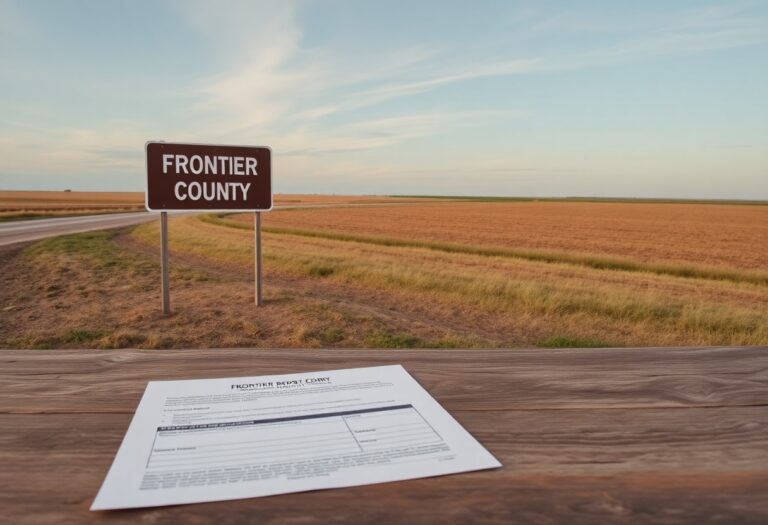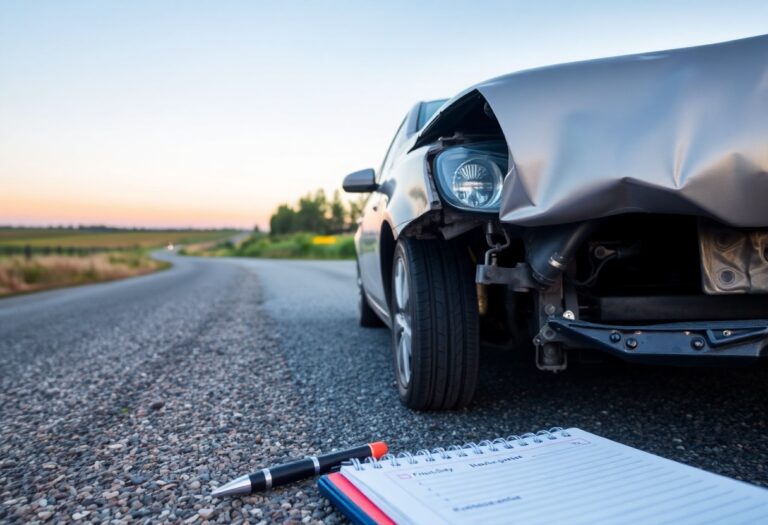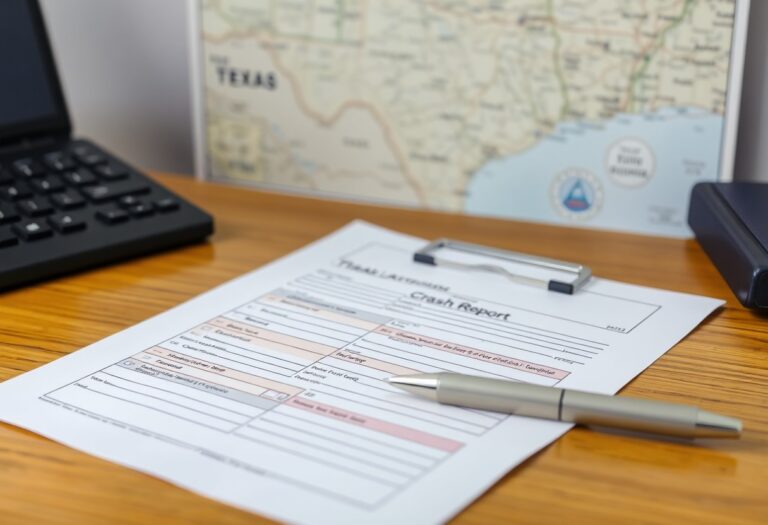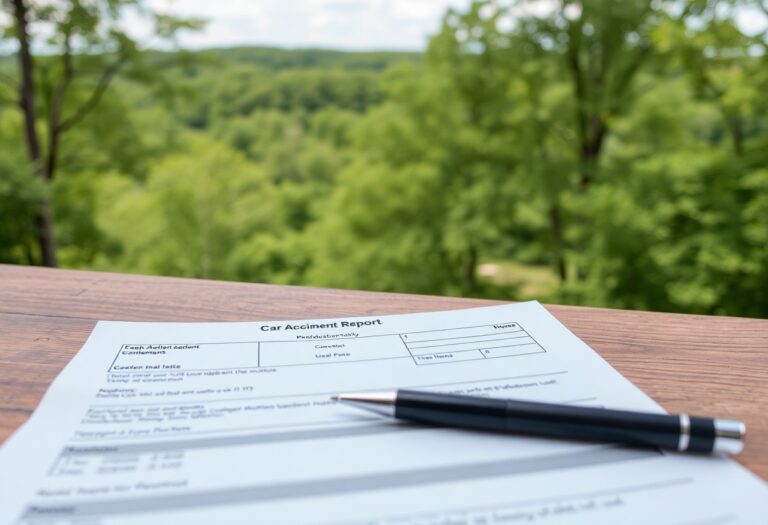Most residents of Nacogdoches County know that navigating the aftermath of a traffic incident can be overwhelming. Whether you’re seeking to obtain a copy of your report or require assistance through the process, the right guidance is necessary. This blog post will equip you with straightforward steps to access your crash report effectively. By following these instructions, you’ll streamline the process and minimize any potential hassles, ensuring that you protect your interests and comply with legal requirements. Stay informed and take control of your situation with the information provided here.
Navigating the Initial Steps of a Crash Report
Following an automobile accident, you must act swiftly and decisively to ensure proper documentation of the incident. The first step involves securing the scene to prevent further collisions, moving vehicles if safe to do so, and checking on the wellbeing of all involved. Collecting key information at the scene is important for creating a comprehensive crash report, which plays a vital role in insurance claims and potential legal proceedings.
Understanding Texas Traffic Accident Reporting Laws
Texas law mandates that any accident resulting in injury, death, or property damage exceeding $1,000 must be reported to law enforcement. This ensures that an official record exists, which is vital for insurance claims and legal matters. Failing to report accidents meeting these criteria could lead to penalties, further complicating your situation.
Gathering Essential Information at the Scene
While at the scene of the crash, focus on gathering important details, including the names and contact information of all parties involved, insurance details, and witness accounts. Photographing the damage, road conditions, and any significant landmarks aids in illustrating the incident’s context later. Documenting the date, time, and weather conditions also provides important context for your report.
In addition to basic details, jotting down license plate numbers, vehicle makes and models, and the exact location of the accident is imperative. Aim to get witness statements if possible, as third-party accounts can validate your recollection of events. A thorough record not only supports your report but enhances the credibility of your claim with insurance agencies and in potential legal disputes.
Documenting Every Detail: The Crash Report Process
Recording the specifics of an accident is important for establishing liability and ensuring your case stands strong. The crash report process involves collecting all vital details from the scene, including eyewitness accounts, vehicle information, and environmental conditions. Working quickly to gather accurate information allows you to present a clear narrative of events, which can be invaluable for insurance claims and potential legal proceedings.
Filling Out the Texas Peace Officer’s Crash Report (CR-3)
The Texas Peace Officer’s Crash Report, also known as the CR-3, is a comprehensive document that law enforcement officers complete after responding to an accident. You will need to provide vital information such as your name, address, date and time of the crash, vehicle descriptions, insurance details, and any injuries sustained. Accuracy in this report is important to protect your rights and interests moving forward.
What to Include: Key Information and Evidence Capture
Key information to include covers the details of the accident scene, involved parties, and any police report numbers. Capture evidence like photographs of vehicle damage, skid marks, road conditions, and license plates. Witness statements can significantly reinforce your position, so gather those early on.
While documenting the accident, focus on capturing not just the facts but also the context surrounding the incident. Take photos from multiple angles, ensuring clarity in images showing damage, road signs, and positions of vehicles. Note weather conditions, visibility, and any factors that may have contributed to the accident. Collect names and contact numbers of witnesses and ensure all the details align with the official police report, as discrepancies can lead to complications in your claims process. By thoroughly documenting every aspect, you equip yourself with a solid foundation for any potential follow-up actions.
Accessing Your Crash Report: A User’s Guide
After you have documented every detail of your automobile accident, accessing your crash report is the next vital step. This document serves as an official record of the incident, detailing crucial information like involved parties, witnesses, and any citations issued by law enforcement. Understanding how to efficiently retrieve your crash report can simplify the claims process and provide you with the necessary evidence to support your case.
How to Obtain Your Crash Report Online
You can conveniently access your crash report online through the Texas Department of Transportation (TxDOT) website. By entering your accident details, including the date and location, you can view and download a digital copy of your report. A nominal fee may apply for this service, ensuring you have immediate access to your information from the comfort of your home.
Alternative Methods: In-Person and Mail Requests
For those who prefer offline methods, you can request your crash report in person or via mail. Visiting your local law enforcement agency or police department that handled the accident can yield immediate results. Alternatively, sending a written request by mail, accompanied by necessary details and identification, allows you to obtain your report without needing to visit in person.
When opting for an in-person request, bring along your driver’s license and any relevant accident documentation to expedite the process. If you choose to send your request by mail, include your full name, address, phone number, the date of the accident, and a self-addressed stamped envelope for the return of your crash report. These methods can take longer than online requests but are still valid ways to secure your documentation. Always check the specific requirements of the agency handling your request to avoid delays and ensure you receive your report accurately.
The Role of Insurance Companies in Crash Reporting
Insurance companies play a key role in processing crash reports, impacting claims and the overall resolution of accident-related disputes. These companies rely on detailed and accurate crash reports to assess liability and determine compensation for damages. You may notice that insurers often require comprehensive information, such as witness statements and police findings, as they analyze not just the physical damages but also the circumstances surrounding the incident. A well-constructed crash report can expedite the claims process and increase your chances of a favorable outcome.
Submitting Your Crash Report to Insurance
Once you have obtained your crash report, the next step is to submit it to your insurance company. You can usually do this through an online claims portal, via email, or by physically mailing a copy. Be sure to include all relevant details and any additional documentation, such as photographs or medical records, to support your claim. This comprehensive approach helps your insurer process your claim more efficiently and reduces the likelihood of delays.
How Insurers Interpret and Utilize Crash Reports
Insurers interpret crash reports by evaluating the facts surrounding the accident, including the location, conditions, and involved parties. They focus on details that indicate fault, like traffic law violations or eyewitness accounts, to determine liability effectively. The more detailed your crash report, the easier it is for the insurance adjuster to accept claims and facilitate compensation. Insurers may also consider historical patterns from your crash report compared to similar incidents when shaping their claims strategy and assessing risk factors.
Your crash report serves as a foundational document for insurance assessments. Adjusters scrutinize various elements, such as the diagram of the accident scene, vehicle damage descriptions, and contributing factors like weather or road conditions, to establish a clearer picture of what occurred. They may compare your report with available evidence, such as surveillance footage, to verify details and support your claim. Understanding how insurers analyze these reports empowers you to present a compelling case, ultimately enhancing your potential for a successful claim outcome.
Common Pitfalls in Crash Reporting: What to Avoid
When filing a crash report, you may encounter several pitfalls that can hinder your case. You should be meticulous in detailing all relevant information about the accident, including the circumstances leading up to it and the event itself. Avoiding vague descriptions or incomplete details can prevent misunderstandings that may later arise in legal proceedings or insurance claims. Double-check any statements and facts before submitting the report to ensure clarity and accuracy, ultimately giving your case a stronger foundation.
Mistakes That Can Complicate Your Case
Common mistakes in crash reporting include failing to collect all necessary witnesses’ testimonies or neglecting to mention pre-existing conditions that may have contributed to the accident. Inaccurate or omitted information can hinder the investigation process and create confusion over liability. Even minor errors in reporting vehicle make or model can provoke disputes with insurance companies about coverage and responsibilities.
How Inaccuracies Can Affect Liability and Claims
Inaccurate reporting can significantly alter the landscape of liability and claims assessment. Insurance companies rely heavily on the information provided in crash reports to determine fault and the extent of damages. If your report contains errors, it can lead to challenges in establishing liability, potentially resulting in reduced compensation or longer claims processes. An inflated or misrepresented detail can also open the door for opposing parties to contest your version of events, complicating the recovery process.
A straightforward, accurate crash report acts as a critical piece of evidence in your case. Inaccuracies not only undermine your credibility but can also lead to unfavorable outcomes. For instance, if your report misstates key details like the time and location of the accident, insurance adjusters might question its legitimacy. This can slow down or even derail compensation if they doubt your claims. Compiling thorough evidence and eliminating inconsistencies helps uphold your position and reinforces the integrity of your case.
Conclusion
From above, you can see that obtaining a crash report in Nacogdoches County, Texas, is a straightforward process when you know the steps to follow. By understanding how to access records through the appropriate channels, you can efficiently manage your post-accident needs. Be sure to gather all necessary information and utilize online resources or local offices to ensure a smooth experience in retrieving your crash report. Your proactive approach is key to navigating this process effectively.













